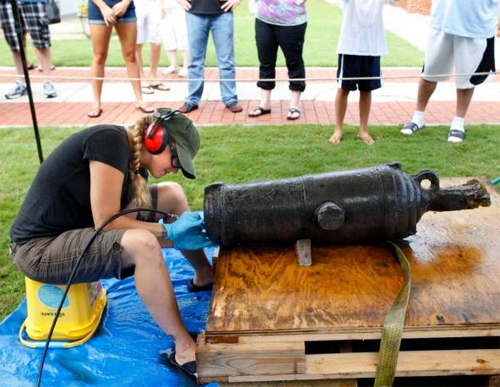
LAMP’s Archaeological Conservator, Starr Cox, uses a pneumatic airscribe to clean the muzzle of the carronade recovered from the 1782 Storm Wreck. Photograph courtesy of the St. Augustine Record
On Friday, 23 August, we temporarily removed our carronade from its conservation vat for a special cleaning session. This carronade along with another cannon was recovered from the Storm Wreck and bears the date 1780. Our goal on Friday was to change out the solution of water and sodium carbonate so the electrolysis treatment could continue, and also to clean the muzzle of the gun in order to get an accurate measurement of its bore diameter. This figure will be used to develop an auger-like device to clean out the bore during a future cleaning session. We also were able to weigh the gun, and discovered a new marking cast into the gun which had previously been obscured by corrosion.

Weighing the carronade: around 440 lbs. Photograph courtesy of the St. Augustine Record.
Our local paper, the St. Augustine Record, came out for the day, which was the first time in a year or so that this gun has been exposed to sunlight and air and public view:
Watching archaeological conservator Starr Cox using an air scribe to clean out the muzzle of an 18th-century carronade at the St. Augustine Lighthouse sort of reminds you of a dental hygienist working on a mouthful of teeth. This patient, though, won’t spit and Cox kept using a water hose to wash away the salt and remaining concretions from the smooth bore, cast-iron weapon.
. . . . The weapon, about 40 inches in length, is thought to be the world’s second-oldest-surviving carronade. When word went out about the find in 2011, an artillery expert from the Tower of London in England contacted Meide to let him know the significance of the piece.
“She had just retired, but she knows her cannons,” Meide said. “The only one older is the one at the Tower of London. … So you can go to the Tower of London or the Tower of St. Augustine to see the two oldest carronades.”
We were able to lift the gun using four people supporting two landscaping timbers bearing straps to secure the gun. Once out of the vat, a heavy-duty scale was rigged to weigh the cannon, which registered about 440 pounds.
The biggest discovery of the day was a three-digit number cast into the left trunnion of the gun. This number was initially obscured by encrustation, but the electolysis cleaning treatment of the past year enabled it to be seen with the naked eye. It is known that the right trunnion on early carronades bore the date of construction, and the left trunnion displayed the serial number of the gun. We are therefore confident that the number, 478, is the serial number. This might help us determine the name of the original owner of this carronade, when we search in the Carron Iron Company archives now housed in Scotland’s National Archives. This in turn might help us identify the name of the Storm Wreck.
At the end of the day, the carronade was put back into its bath and the electrical current was again switched on. Stay tuned for more updates on this and the other gun as we learn more about them . . .

